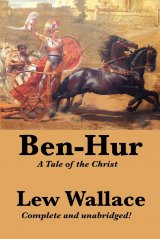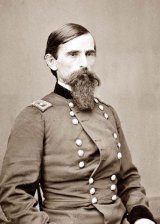Ben-Hur Page #15
Ben-Hur: A Tale of the Christ is a novel by Lew Wallace, published by Harper and Brothers on November 12, 1880, and considered "the most influential Christian book of the nineteenth century". It became a best-selling American novel, surpassing Harriet Beecher Stowe's Uncle Tom's Cabin in sales.
To the Jew of that period, moreover, abode in caverns was a familiar idea, made so by every-day occurrences, and by what he heard of Sabbaths in the synagogues. How much of Jewish history, how many of the many exciting incidents in that history, had transpired in caves! Yet further, these people were Jews of Bethlehem, with whom the idea was especially commonplace; for their locality abounded with caves great and small, some of which had been dwelling-places from the time of the Emim and Horites. No more was there offence to them in the fact that the cavern to which they were being taken had been, or was, a stable. They were the descendants of a race of herdsmen, whose flocks habitually shared both their habitations and wanderings. In keeping with a custom derived from Abraham, the tent of the Bedawin yet shelters his horses and children alike. So they obeyed the keeper cheerfully, and gazed at the house, feeling only a natural curiosity. Everything associated with the history of David was interesting to them. The building was low and narrow, projecting but a little from the rock to which it was joined at the rear, and wholly without a window. In its blank front there was a door, swung on enormous hinges, and thickly daubed with ochreous clay. While the wooden bolt of the lock was being pushed back, the women were assisted from their pillions. Upon the opening of the door, the keeper called out, "Come in!" The guests entered, and stared about them. It became apparent immediately that the house was but a mask or covering for the mouth of a natural cave or grotto, probably forty feet long, nine or ten high, and twelve or fifteen in width. The light streamed through the doorway, over an uneven floor, falling upon piles of grain and fodder, and earthenware and household property, occupying the centre of the chamber. Along the sides were mangers, low enough for sheep, and built of stones laid in cement. There were no stalls or partitions of any kind. Dust and chaff yellowed the floor, filled all the crevices and hollows, and thickened the spider-webs, which dropped from the ceiling like bits of dirty linen; otherwise the place was cleanly, and, to appearance, as comfortable as any of the arched lewens of the khan proper. In fact, a cave was the model and first suggestion of the lewen. "Come in!" said the guide. "These piles upon the floor are for travellers like yourselves. Take what of them you need." Then he spoke to Mary. "Can you rest here?" "The place is sanctified," she answered. "I leave you then. Peace be with you all!" When he was gone, they busied themselves making the cave habitable. CHAPTER X. At a certain hour in the evening the shouting and stir of the people in and about the khan ceased; at the same time, every Israelite, if not already upon his feet, arose, solemnized his face, looked towards Jerusalem, crossed his hands upon his breast, and prayed; for it was the sacred ninth hour, when sacrifices were offered in the temple on Moriah, and God was supposed to be there. When the hands of the worshippers fell down, the commotion broke forth again; everybody hastened to bread, or to make his pallet. A little later, the lights were put out, and there was silence, and then sleep. * * * * * * About midnight some one on the roof cried out, "What light is that in the sky? Awake, brethren, awake and see!" The people, half asleep, sat up and looked; then they became wide-awake, though wonder-struck. And the stir spread to the court below, and into the lewens; soon the entire tenantry of the house and court and enclosure were out gazing at the sky. And this was what they saw. A ray of light, beginning at a height immeasurably beyond the nearest stars, and dropping obliquely to the earth; at its top, a diminishing point; at its base, many furlongs in width; its sides blending softly with the darkness of the night, its core a roseate electrical splendor. The apparition seemed to rest on the nearest mountain southeast of the town, making a pale corona along the line of the summit. The khan was touched luminously, so that those upon the roof saw each other's faces, all filled with wonder. Steadily, through minutes, the ray lingered, and then the wonder changed to awe and fear; the timid trembled; the boldest spoke in whispers. "Saw you ever the like?" asked one. "It seems just over the mountain there. I cannot tell what it is, nor did I ever see anything like it," was the answer. "Can it be that a star has burst and fallen?" asked another, his tongue faltering. "When a star falls, its light goes out." "I have it!" cried one, confidently. "The shepherds have seen a lion, and made fires to keep him from the flocks." The men next the speaker drew a breath of relief, and said, "Yes, that is it! The flocks were grazing in the valley over there to-day." A bystander dispelled the comfort. "No, no! Though all the wood in all the valleys of Judah was brought together in one pile and fired, the blaze would not throw a light so strong and high." After that there was silence on the house-top, broken but once again while the mystery continued. "Brethren!" exclaimed a Jew of venerable mien, "what we see is the ladder our father Jacob saw in his dream. Blessed be the Lord God of our fathers!" CHAPTER XI A mile and a half, it may be two miles, southeast of Bethlehem, there is a plain separated from the town by an intervening swell of the mountain. Besides being well sheltered from the north winds, the vale was covered with a growth of sycamore, dwarf-oak, and pine trees, while in the glens and ravines adjoining there were thickets of olive and mulberry; all at this season of the year invaluable for the support of sheep, goats, and cattle, of which the wandering flocks consisted. At the side farthest from the town, close under a bluff, there was an extensive marah, or sheepcot, ages old. In some long-forgotten foray, the building had been unroofed and almost demolished. The enclosure attached to it remained intact, however, and that was of more importance to the shepherds who drove their charges thither than the house itself. The stone wall around the lot was high as a man's head, yet not so high but that sometimes a panther or a lion, hungering from the wilderness, leaped boldly in. On the inner side of the wall, and as an additional security against the constant danger, a hedge of the rhamnus had been planted, an invention so successful that now a sparrow could hardly penetrate the overtopping branches, armed as they were with great clusters of thorns hard as spikes. The day of the occurrences which occupy the preceding chapters, a number of shepherds, seeking fresh walks for their flocks, led them up to this plain; and from early morning the groves had been made ring with calls, and the blows of axes, the bleating of sheep and goats, the tinkling of bells, the lowing of cattle, and the barking of dogs. When the sun went down, they led the way to the
Translation
Translate and read this book in other languages:
Select another language:
- - Select -
- 简体中文 (Chinese - Simplified)
- 繁體中文 (Chinese - Traditional)
- Español (Spanish)
- Esperanto (Esperanto)
- 日本語 (Japanese)
- Português (Portuguese)
- Deutsch (German)
- العربية (Arabic)
- Français (French)
- Русский (Russian)
- ಕನ್ನಡ (Kannada)
- 한국어 (Korean)
- עברית (Hebrew)
- Gaeilge (Irish)
- Українська (Ukrainian)
- اردو (Urdu)
- Magyar (Hungarian)
- मानक हिन्दी (Hindi)
- Indonesia (Indonesian)
- Italiano (Italian)
- தமிழ் (Tamil)
- Türkçe (Turkish)
- తెలుగు (Telugu)
- ภาษาไทย (Thai)
- Tiếng Việt (Vietnamese)
- Čeština (Czech)
- Polski (Polish)
- Bahasa Indonesia (Indonesian)
- Românește (Romanian)
- Nederlands (Dutch)
- Ελληνικά (Greek)
- Latinum (Latin)
- Svenska (Swedish)
- Dansk (Danish)
- Suomi (Finnish)
- فارسی (Persian)
- ייִדיש (Yiddish)
- հայերեն (Armenian)
- Norsk (Norwegian)
- English (English)
Citation
Use the citation below to add this book to your bibliography:
Style:MLAChicagoAPA
"Ben-Hur Books." Literature.com. STANDS4 LLC, 2024. Web. 26 Nov. 2024. <https://www.literature.com/book/ben-hur_1675>.




Discuss this Ben-Hur book with the community:
Report Comment
We're doing our best to make sure our content is useful, accurate and safe.
If by any chance you spot an inappropriate comment while navigating through our website please use this form to let us know, and we'll take care of it shortly.
Attachment
You need to be logged in to favorite.
Log In